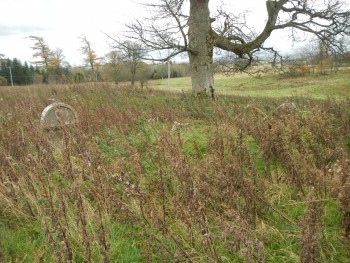- Navigation:
- Back to the Corpus index page
- RSS
Clerkington Parish Church
Clerkington Church site, 1
- Dedication: unknown
- Diocese of St Andrews
- Deanery of Haddington/Lothian
- NT 3055 5762
Historical outline
Dedication: unknown
Little is known of the church and parish of Clerkington before the fourteenth century. The first surviving recorded reference to it is in the papal tax-collector’s rolls of the mid-1270s, where it was presented as a free parsonage and assessed for taxation at 6s 6d in the roll for the deanery of Haddington and then double-entered in the same roll at half a merk (6s 8d).(1)
The church came into the patronage of the Bissets through marriage in the early 1300s and in 1328-29 Christina Bisset, lady of Clerkington, in her pure widowhood, granted the advowson to the monks of Newbattle for the souls of herself and her late husband, John Bisset.(2) According to her charter, the right of advowson belonged to her by heritage, presumably as the heiress to Clerkington. She confirmed her grant in a second charter, dated at Newbattle on 4 June 1338, which her son, Walter Bisset, confirmed in his own charter.(3) The gift was again confirmed by her in 1357.(4) All of these efforts to bestow the advowson on Newbattle appear to have been ineffective and the church was still independent into the 1440s.
In 1444, Bishop James Kennedy of St Andrews assigned the whole fruits of the church to the provostry of the collegiate church of Corstorphine.(5) Both the parsonage and the vicarage were successfully annexed at this time and remained so at the Reformation, although in the Books of Assumption certain teinds from Clerkington, valued at £6 13s 4d, were listed amongst the properties of the St Andrews priory.(6) The cure was served by a vicar pensioner from the time of the annexation of the church to Corstorphine.
Notes
1. A I Dunlop (ed), ‘Bagimond’s Roll: the Statement of the Tenths of the Kingdom of Scotland’, Miscellany of the Scottish History Society, vi (1939), 57, 58.
2. Registrum S Marie de Neubotle (Bannatyne Club, 1849), Carte Originales, no.VIII [hereafter Newbattle Registrum].
3. NRS GD40/1/46; Newbattle Registrum, Carte Originales, nos IX, X.
5. Charters of the Hospital of Soltre, of Trinity College, Edinburgh, and other Collegiate Churches in Midlothian (Bannatye Club, 1861), 298-304.
6. J Kirk (ed), The Books of Assumption of the Thirds of Benefices (Oxford, 1995), 8.
Architectural description
There was an ineffective attempt in about 1338 by Dame Christian Byseth to grant the church at Clerkington to the Cistercian abbey of Newbattle. The church eventually lost its independence when it was assigned to the provostry of the collegiate church at Corstorphine by Bishop James Kennedy in 1444.(1) For a period after the Reformation the parish was served by a reader, but was evidently soon afterwards united with Moorfoot and Temple, with the place of worship at Temple.(2)
Although the churchyard continued in use for burials, the church was itself was evidently soon afterwards abandoned, and now survives as no more than fragmentary footings. Its site is a mound in a field of rough pasture at the northern edge of the Rosebery House policies, with a few monuments emerging from the vegetation. It is thought to have been a two-compartment structure with overall dimensions of about 17 by 6 metres.(3)
Notes
1. Ian B. Cowan, The Parishes of Medieval Scotland (Scottish Record Society), 1967, pp. 31-32.
2. Statistical Account of Scotland, 1791-99, vol. 16, pp. 502-03; New Statistical Account of Scotland, 1834-45, pp. 53-54.
3. Royal Commission on the Ancient and Historical Monuments of Scotland, Canmore online resource.
Map
Images
Click on any thumbnail to open the image gallery and slideshow.





